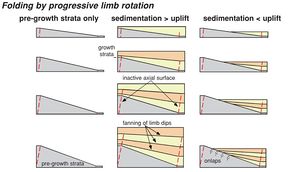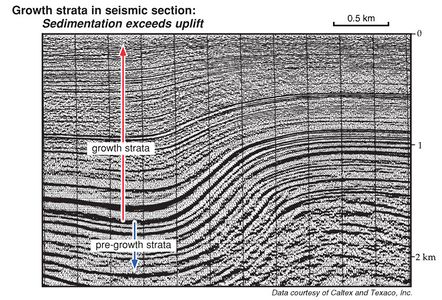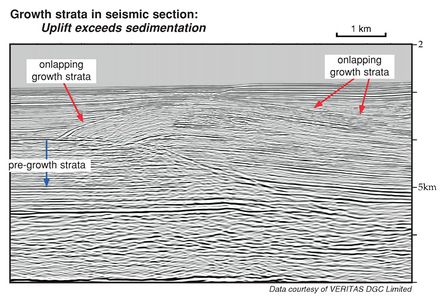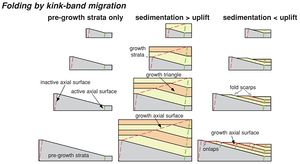Growth strata
This page is under construction
| Seismic Interpretation of Contractional Fault-Related Folds: An AAPG Seismic Atlas | |

| |
| Series | Studies in Geology |
|---|---|
| Part | Part 1 |
| Chapter | Structural Interpretation Methods |
| Author | John H. Shaw, Christopher D. Connors, and John Suppe |
| Link | Web page |
| PDF file (requires access) | |
| Store | AAPG Store |
Growth or syntectonic strata are stratigraphic intervals that were deposited during deformation. The ages of growth strata therefore define the timing of deformations. In contractional fault-related folds, growth strata typically thin across fold limbs toward structural highs. The geometries of growth structures are controlled primarily by the folding mechanism and the relative rates of sedimentation and uplift. Thus, growth fold patterns imaged in seismic data are often considered diagnostic of folding mechanism and sediment-to-uplift ratio. In this section, we describe common patterns of growth strata in fault-related folds that are imaged in seismic reflection data.
Figure 1 In cases where the sedimentation rate exceeds the uplift rate, growth strata are typically characterized as sequences, bounded by two or more seismic reflections, that thin toward the structural high. Growth strata are generally folded in one or more limbs of the structure. In this seismic section, growth strata thin onto the fold crest, with the lowermost growth units exhibiting the greatest thickness changes. (2-D seismic data, reprinted from Shaw et al.[1]).
Figure 2 In cases where the uplift rate exceeds the sedimentation rate, growth strata typically thin toward, and onlap, the structural high. Growth strata are generally not present above the fold crest, but are folded in one or more limbs of the structure. In this seismic section, growth strata onlap the backlimb and forelimb of a fault-related fold. The growth strata are overlain by post-tectonic strata, which are described later in this article.
Growth strata as records of fold kinematics
Two folding mechanisms — kink-band migration and limb rotation — are commonly ascribed to contractional fault-related folds. These folding mechanisms typically yield distinctive patterns of deformed growth strata above fold limbs. Thus, seismic images of growth folds can be used to identify the folding mechanisms, which in turn can dictate the kinematic theory (e.g., fault-bend folding or detachment folding) that is most appropriate to guide the structural interpretation of the seismic data.
In fault-related folds that develop purely by kink-band migration, fold limbs widen through time while maintaining a fixed dip,[2] as illustrated in the sequential model involving pre-growth strata only (Figure 3, left). Material is incorporated into the fold limb by passing through an active axial surface, which at depth is generally pinned to a bend or tip of a fault.[3][4] The fold limb in growth strata is bounded by the active axial surface and the growth axial surface, an inactive axial surface that defines the locus of particles originally deposited along the active axial surface. In these sequential models (Figure 3, left), the synclinal axial surface is active, and the anticlinal axial surface is inactive.
In the case where sedimentation rate exceeds uplift rate (Figure 3, center), strata are folded through the synclinal axis and incorporated into the widening fold limb. The dip of folded growth strata is equal to dip of the fold limb in pre-growth strata. The width of the dip panel for each growth horizon corresponds to the amount of fold growth that occurred subsequent to the deposition of that marker. As a result, younger horizons have narrower fold limbs than do older horizons, forming narrowing upward fold limbs or kink bands in growth strata (growth triangles). In the case where uplift rate exceeds sedimentation rate (Figure 3, right), each increment of folding produces a discrete fold scarp located where the active axial surface projects to the Earth’s surface.[5] Subsequent deposits onlap the fold scarp, producing stratigraphic pinchouts above the fold limb. Fold scarps and stratigraphic pinch-outs are displaced laterally and folded as they are incorporated into widening limbs.
Contractional fault-related folding theories that exclusively invoke kink-band migration include fault-bend folding,[3] constant-thickness and fixed axis fault-propagation folding,[4] and basement-involved (triple junction) folding.[6]

Growth structures in seismic data
asdf
References
- ↑ Shaw, J. H., S. C. Hook, and B. Satrio, 1997, Complex structural reactivation defined by growth strata: AAPG Annual Meeting Abstracts, v. 6, p. 106.
- ↑ Suppe, J., G. T. Chou, and S. C. Hook, 1992, Rates of folding and faulting determined from growth strata, in K. R. McClay, ed., Thrust tectonics; London, Chapman, and Hall, p. 105-121.
- ↑ 3.0 3.1 Suppe, J., 1983, Geometry and kinematics of fault-bend folding: American Journal of Science, v. 283, p. 684-721.
- ↑ 4.0 4.1 Suppe, J., and D. A. Medwedeff, 1990, Geometry and kinematics of fault-propagation folding: Ecolg. Geol. Helf., v. 83, p. 409-454.
- ↑ Shaw, J. H., E. Novoa, and C. Connors, 2004, Structural controls on growth stratigraphy in contractional fault-related folds, in K. R. McClay, ed., Thrust tectonics and hydrocarbon systems: AAPG Memoir 82, p. 400-412.
- ↑ Narr, W., and J. Suppe, 1994, Kinematics of basement-involved compressive structures: American Journal of Science, v. 294, p. 802-860.


